|
APHA Color Patterns
Grullo
Overo
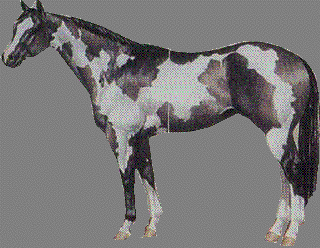
The body color is smoky or mouse-colored(not a mixture of black
and white hairs, but each hair is mouse-colored).
The mane and tail may be black, white or both and there is typically
black on the lower legs.
Pictured Above Description - grullo overo with blaze, left fore
pastern and three stockings.
Sorrel Overo
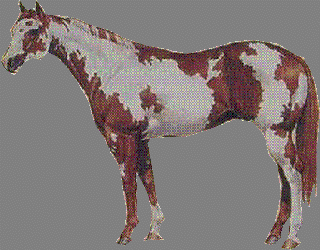
The body is a clear reddish or copper-red color.
The mane and tail are usually the same color as the body and
may be flaxen or white.
Pictured Above Description - sorrel overo with bald face, right
fore sock and left hind stocking.
Palomino
Overo
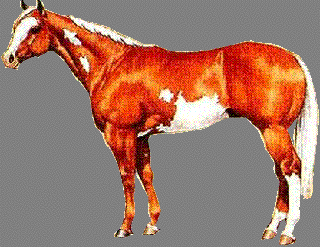
The body color is a shade of yellow or gold.
The mane and tail are white, yellow or gold.
Palominos do not have dorsal stripes like the similarly colored
dun horse.
Pictured Above Description - palomino overo with blaze, right
fore coronet, right rear sock and left hind stocking.
Red Roan Overo
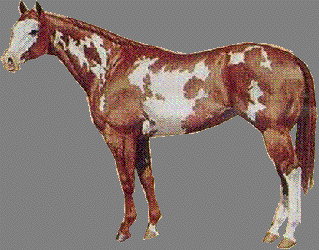
A red roan is more or less a uniform mixture of white with red
hair.
The mane and tail may be red, black, flaxen or white.
Pictured Above Description - red roan overo with bald face and
right fore pastern and hind stockings.
Red
Dun Tovero
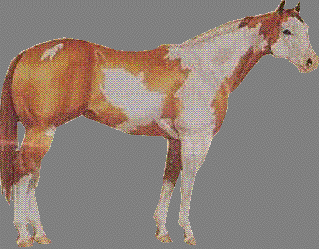
Red dun is a form of dun typically with a yellow- or flesh-colored
body.
The mane, tail and dorsal stripe may be red, white or both.
Pictured Above Description - red dun tovero with bald face and
four stockings.
Sabino
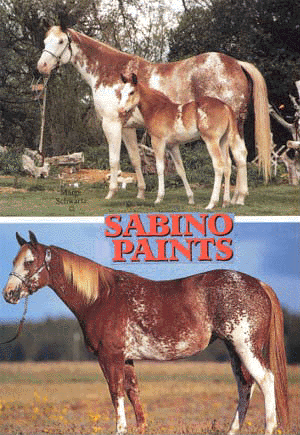
The term Sabino (Sah-BEE-no) seems to be one of the most confusing
and least understood. In the dictionary of Western Words,Ramon
F. Adams lists sabino as being Spanish for "a horse with light
red, almost pink, roan-colored body and a pure white belly."
It accurately descripes one of the many variants of the pattern,
the one at the median of the spectrum. Minimally-expressed,
the sabino pattern manifests itself in the form of white markings
on the head and legs on an otherwise solid horse.
They are sometimes confused with solid horses that have unusual
white markings. The sabinos differ in that their white markings
tend to have narrow, pointed extensions up the legs or down
the throat. Minimally-marked red roan sabinos are often confused
with the classic red roan horses with only defference being
sabino's extended leg and face markings.
As the pattern progresses (through age) even farther with white
extending higher up legs, in some instances the head becomes
completely white, or apron or bonnet faced. Belly spots appear
that are often visible from the side. It becomes more flecked
or speckled over the entire body. The belly and the head are
often completely white. This phase of the pattern is probably
the most readily identifiable as the sabino. Finally in its
maximally-expressed form, the sabino pattern evolves into an
extremely white horse.
Pictured Above are examples of Sabinos
MARKINGS
These colors, markings, and patterns come in any shape or size.
They can be located virtually any where on the Paint's body.
Paints come in varity of colors with different markings but
keep in mind there are only three coat patterns.
Overo(pronounced:
oh vair' oh) The white usually will not cross the back of the
horse between its withers and its tail. Generally, at least
one and often all four legs are dark. The is irregular and is
rather scattered or splashy. Head markings are distinctive,
often baldfaced, apron-faced or bonnet faced. An overo may be
either predominantly dark or white. The tail is usually one
color.
Tobiano(pronounced: tow be yah' no) The
dark color usually covers one or both flanks. Generally, all
four legs are white, at least below the hocks and knees. The
spots are regular and distinct as ovals or round patterns that
extend down over the neck and chest, giving the appearance of
a shield.
Head markings are like those of a solid-colored horse - solid
or with a blaze, strip, star or snip. A tobiano may bve either
predominantly dark or white. The tail is often two colors.
Tovero(pronounced: tow vair' oh) These horses combine
the characteristics of both overos and tobianos. These colors,
markings, and patterns combined with conformation, athletic
ability and agreeable disposition make the APHA horse an investment
in quality and an eye-catching addition to anyone's barn.
For more information on colors and patterns of the American
Paint Horse I have added an address below.
AMERICAN
PAINT HORSE ASSOCIATION
Post Office Box 961023
Fort Worth, Texas 76161-0023
(817)834-APHS(2742)~ www.apha.com
|
|
|